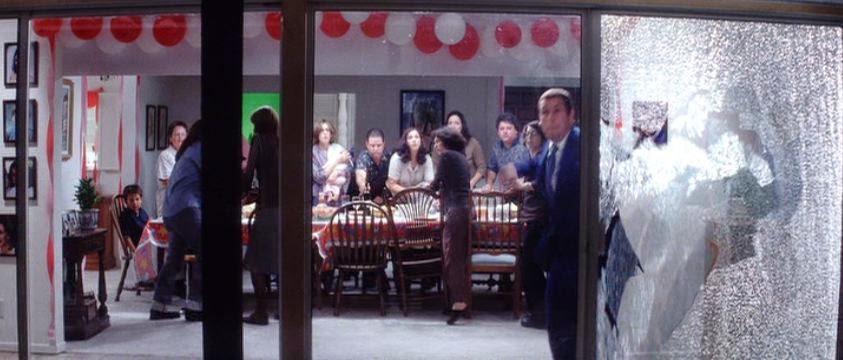Citizen Kane is a 1941 classic movie starring, written, directed, and produced by Orson Welles... some people overachieve, this guy superachieved. And one of the things that he achieved was hiring visionary Cinematographer Gregg Toland. Known for his trademark "Deep Focus", a technique that allows the foreground, middleground, and background of a shot to be in the same focus, Toland was nominated for an Oscar award for Citizen Kane (he won one Oscar for the movie adaptation of "Wuthering Heights"). His astounding skill in the medium of film has inspired many filmmakers since his time, because he was so visionary. He practically wrote the book on camerawork by literally inventing many shots in the movie. One of my favorite scenes (and DEFINITELY my favorite shot) in the film is about 71 minutes in to the movie. It takes place in the Kane campaign headquarters, and the whole scene is filmed in 1 shot. Just one. The camera is juxtaposed so that it seems like it is on the floor, a mild high-angle, mid-long shot up at the screen, with a wide lens to get all the action. As the scene progresses, the camera slowly pans right, catching both Charlie Kane and Jed Leland in an argument. The characters, growing more drunk, make their way toward the camera, which does not move, and it goes from a mild high-angle shot to a severe high-angle shot, evoking an emotion of fear and seemingly suggesting ideas of tension and growing animosity between the characters. This clearly exemplifies the idea that the shot can affect your outlook not only on the characters, but on the themes of the film as well. The shot was genius, and was a turning point in the movie for me. It comes on as a little slow in the beginning, but I clearly noticed the revolutionary cinematography at this point, and became more involved with the film.

This film is widely regarded as one of the best of all time, and for good reason. The complex plot, fantastic filmmaking, and acting help it rise continually to film nirvana. It follows the story of Charles Foster Kane through the eyes of a news man, from his humble beginnings as an orphan to his rise to stardom, and then to his untimely demise, and the last words of a giant. In the opinion of this critic, it deserves 4/5 STATUES, Charlie's collectors item, for a timeless, visionary classic, that just wasn't always my cup of tea. (This one even looks like Orson Welles)
The next movie is a Paul Thomas Anderson film called Punch-Drunk Love, starring Adam Sandler, Emma Watson, and my favorite actor in the history of forever, Philip Seymour Hoffman. It centers around Barry Egan, a socially and mentally troubled business owner, who falls in love with a friend of one of his seven sisters, and comes to be extorted by a crooked mattress man who runs a phone-sex line. From the beginning, this film seems unusual. Shot in widescreen filmstock with a wide lens, it seems to want to make you uncomfortable. The shots, often coming from awkward angles, coupled with the sporadic and disjointed music evokes frustration and almost paranoia. It portrays the idea that everything is not alright in Barry's brain, and sure makes you feel it. My favorite shot in the movie comes around at about 81 minutes in. Philip Seymour Hoffman's character Dean is getting a haircut in his mattress store as the camera films him from a left angle. The camera swings slowly around as the characters look to a doorway and Barry's form comes into view. This great shot leads to a great scene, and Philip Seymour Hoffman performs the whole thing in a barber cape.
I love this movie! It has a brilliant plot, sensational actors, and is just plain entertaining. That deserves, in this critic's opinion, 5/5 broken windows.
The last film that I watched this week was the all sci-fi, all spanish Guillermo Del Toro epic, Pan's Labyrinth. This film follows the story of Ofelia, stepdaughter of an evil Captain in the Spanish Civil War. When Ofelia and her mother, pregnant with the Captain's son, come to stay at his headquarters, Ofelia meets Pan, a faun who tells her that she is destined to be the princess of a magical world. The keyword for this movie is Special Visual Effects. Director of Photography Guillermo Navarro composes his shots flawlessly, and won an Oscar for the movie, and it is stunning in the camerawork department, but the people who really, REALLY deserve their Oscars are Eugenio Caballero (art director), Pilar Revuelta (set director), David Marti, and Montse Ribe (makeup artists). Everything that really makes this movie unique comes from these five people (including the DP), because the real hallmark of the movie is the effects on the characters Pan and Pale Man that were created almost entirely in the physical, without CGI. Actor Doug Jones deserved something for his role as both of these characters for sitting in makeup for at least 5 hours and learning the Spanish language solely for this movie. And the effects are certainly noticeable. Film is an art form, and everything in a film is a separate work of art. The more art that can exist in the physical medium of the movie, without the assistance of CGI, contributes immensely to the natural feel of a film. This film feels very natural, and the flawless Cinematography really makes the fantastic world of the labyrinth come to life (cliche alert).
Overall, this film is a flawless testament to the marvels of film-making and Cinematography, but this horror-and-gore-hating critic takes 1/2 of for being not quite my cup of tea. Overall, 4.5/5 fauns, who creep you out the whole time, but turn out to be good friends in the end.
............noooooooooooooope. Still creepy. That noise he makes just... yeesh.



